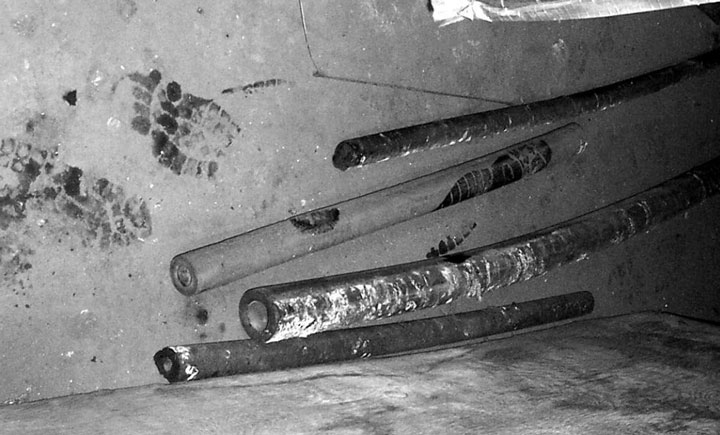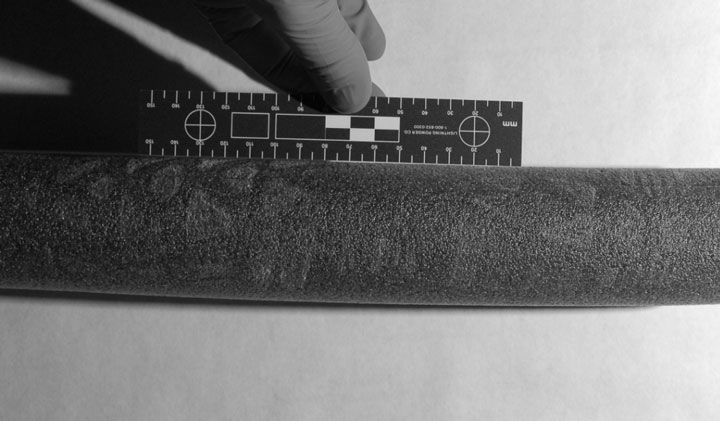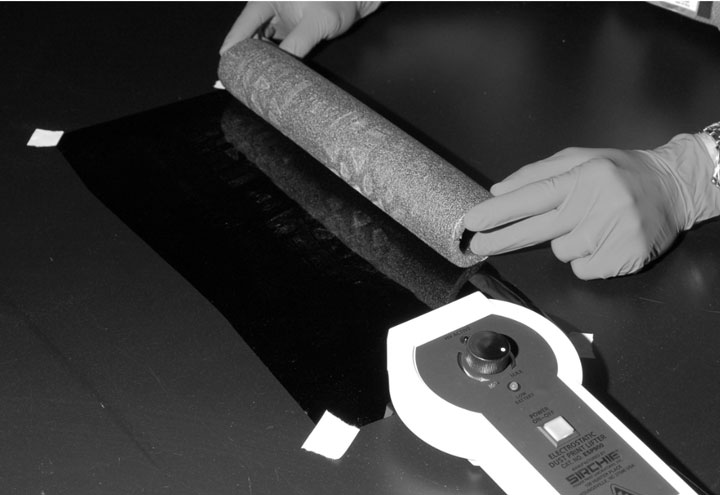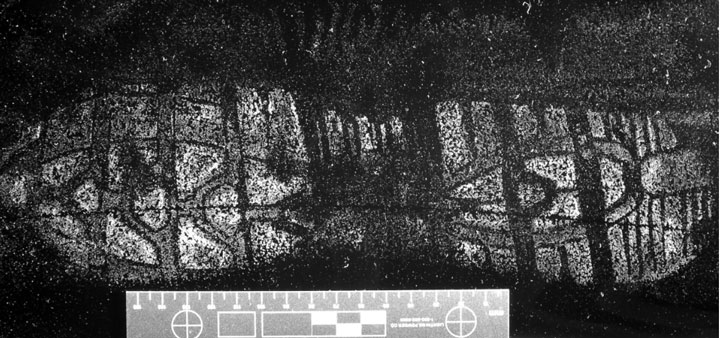Lifting Shoe Impressions from Cylindrical Objects: A Simple Method
Thomas W. Adair and Richard Tewes
See also the instructional videos on "Footwear Impressions"
The use of electro-static dust lifting devices to obtain shoe impressions has been well documented and accepted by the forensic community.1,2 These devices operate by inducing an electrical charge to a sheet of metalized film that has been placed over the crime scene impression. The electrical charge attracts the particles of the shoe impression, transferring it to the lifting film. Electro-static lifting is generally considered an non-destructive process and is an ideal step to follow traditional photography techniques. This method works very well on surfaces which are smooth, hard, and dry, such as countertops, glass, and doors. These types of surfaces typically allow for near total contact between the film and the surface containing the impression. A rubber roller can also be used to smooth out the film over the surface.
By way of contrast, cylindrical surfaces pose several challenges to the analyst. Cylindrical, or curved, surfaces may be much more difficult to photograph than flat surfaces due to lighting and depth of field issues. Generally speaking, the greater the curvature of the object, the greater the difficulty the analyst will likely encounter during the documentation process. In addition, traditional lifting techniques may not be well suited for curved surfaces. The inability to properly secure lifting film over the impression area may lead to slippage and subsequent damage or distortion to the impression while rolling. The inability to make near total contact between the lifting film and the impression may also lead to undesirable gaps or wrinkles in the film. These difficulties are significantly increased when the curved surface is soft and flexible.
In the Winter of 2005 the senior author was reviewing photographs from a burglary scene when he observed a shoe impression on a section of foam pipe insulation (figure 1). Patrol officers had responded to the scene and taken photographs but had not seen the shoe impression on the foam. The foam insulation was located in the ceiling of a commercial business near the point of forced entry on the roof. Patrol officers did not collect the foam and the object was subsequently discarded by the property owner soon after.

Figure 1
The challenge of lifting a shoe impression from a “soft” or flexible curved object was very intriguing. Even though the crime scene evidence was not submitted for examination, the authors decided to replicate the evidence and attempt a recovery of the shoe impression in an experiment. The authors obtained standard 2 ¼” foam insulation strips typically used to insulate copper water pipes. Several dusty shoe impressions were made with various mediums such as dirt, carpet dust, and drywall dust. The impressions were placed on the foam in various orientations by stepping on the foam as if walking. A Sirchie model ESP900 electro-static lifting device was used for all experiments. It was observed that the main difficulty in obtaining impressions with electro-static film on curved surfaces was in the application of the film to the object containing the shoe impression. It was therefore hypothesized that better results might be obtainable by reversing the approach and applying the object to the lifting film.

Figure 2
Photographs of the impressions on the test foam were taken prior to lifting attempts (figure 2). The quality of the photographs, for examination purposes, was poor. This was in part due to the lack of contrast between the impression and the background, the texture of the background, and the difficulty experienced in achieving even oblique lighting. A sheet of lifting film was secured to a flat countertop with the metalized (silver) side down. The corners of the film were secured with “safe release” Scotch brand masking tape. The lifting device was placed as it normally would be on the edge of the film with a grounding plate. The unit was turned on and the foam section was “rolled” once over the film with light pressure from the sides (figure 3). Pressure was not applied to the areas of the foam containing the impression. Figure 4 shows excellent results of a single pass onto the lifting film. Measurements of the subsequent lifted impression were compared with the original impression (on the foam) with no significant distortion observed.

Figure 3

Figure 4
Crime scene analysts rarely encounter footwear impressions on cylindrical objects. In most crime scenes, two dimensional impressions are typically found on smooth, hard surfaces such as floors, counters, doors, or glass. Occasionally however, analysts may encounter impressions contained on cylindrical objects such as bottles, baseball bats, handrails, or in this case, insulated pipe foam. These impressions can be very challenging to document and collect using traditional methods of photography and electro-static lifting due to the physical curvature of the object containing the impression. While the need for this lifting method may remain rare in general crime scene processing examiners should consider this method when faced with movable cylindrical or curved surfaces.
References
- Bodziak, W.J. 1995. Footwear Impression Evidence. CRC Press, Boca Raton FL. 421 pps.
- Cassidy, M.J. 1995. Footwear Identification. Lightning powder Company. Salem, OR. 176 pps.
About the Authors
Thomas W. Adair
Senior Criminalist
Westminster Police Department
9110 Yates Street
Westminster, CO 80031
Richard Tewes
Manager of Forensic Services
Fort Collins Police Department
300 LaPorte Ave
Fort Collins, CO 80521
 This is an Open Access article distributed under the terms of the Creative Commons Attribution-NonCommercial-NoDerivatives 4.0 International License which permits unrestricted noncommercial use, distribution, and reproduction, provided the original work is properly cited and not changed in any way.
This is an Open Access article distributed under the terms of the Creative Commons Attribution-NonCommercial-NoDerivatives 4.0 International License which permits unrestricted noncommercial use, distribution, and reproduction, provided the original work is properly cited and not changed in any way.
Article submitted by the authors. The Crime Scene Investigator Network gratefully acknowledges the authors for allowing us to reproduce the article.

